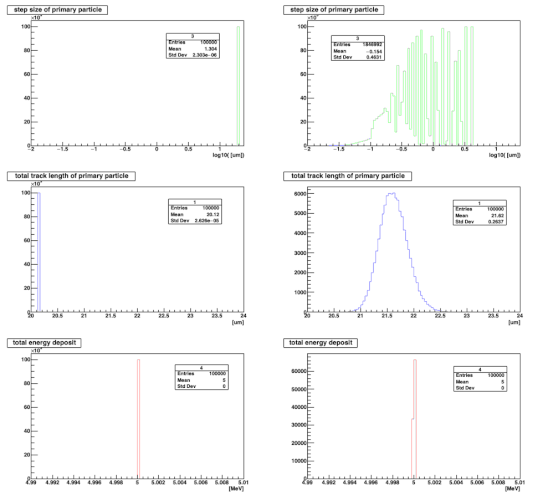I generated 5 MeV alpha particles impinging on a Carbon detector of a thickness larger than particle range. Measuring deposited energy in Carbon I noticed that if ionIonisation process has no steps, i.e. StepFunction() is larger than the particle range, then deposited energy is equal to the initial alpha energy, instead if I set StepFunction() less than particle range and >1 step is made by the particle the total deposited energy is smaller than alpha energy (order of 8 keV out of 5 MeV) and an additional deposited energy fluctuation is added (likely proportional to the number of steps). Is it some kind of approximation?
Here a macro for example TestEm1 and associated plots.
The first column is without step limitation, eg. step size = 1. * initial range
The second column is with step limitation, eg. step size = 0.2 * current range
Notice that, in histo 4, the energy bin is 200 eV
mikhail.mac.txt (847 Bytes)
Thank you Maire,
but I am not sure what I see: do you get Landau distribution on right bottom plot? Why not delta function? What version of geant4 are you using? Could you also provide your parameters of ionization for alpha? I tried these different values but now using these:
hIoni: for alpha SubType= 2
dE/dx and range tables from 10 eV to 10 MeV in 702 bins
Lambda tables from threshold to 10 MeV, 117 bins per decade, spline: 1
finalRange(mm)= 1e-06, dRoverRange= 0.1, integral: 1, fluct: 1, linLossLimit= 1e-06
===== EM models for the G4Region DefaultRegionForTheWorld ======
ParamICRU73 : Emin= 0 meV Emax= 7.9452 MeV deltaVI
BetheBloch : Emin= 7.9452 MeV Emax= 10 MeV
CSDA range table up to 10 MeV in 702 bins
I am getting a Gaussian distribution of deposited energy.
It is a delta function ! with a numerical rounding (less than 0.2 keV) : with stepFunction = 0.2, there are ~18 steps per track.
Attached, the relevant parts of the output of TestEm1. I am using G4 10.6
Please, run the macro on your installation, and show your histogram 4
mikhail.mac.txt (847 Bytes)
mikhail.out.txt (6.0 KB)
Hello,
Whatever parameters and number of steps the result should be the same - total kinetic energy of alpha. Fluctuations should not change this condition.
VI
Hello Vladimir,
unfortunately it didn’t work as expected. I am using version: geant4.10.03.p01, so perhaps there are some differences with respect to the most recent release. For “alpha” I had the following EmPhysiscs:
“ph->RegisterProcess(new G4hMultipleScattering(), particle);
G4ionIonisation* ionIoni = new G4ionIonisation();
ionIoni->SetEmModel(new G4IonParametrisedLossModel());
ionIoni->SetStepFunction(0.1, 10*nm);
ph->RegisterProcess(ionIoni, particle);”
and when steps were small a part (very small fraction ~1.e-3) of full energy was disappearing, instead with single step absorption (1 mm step) full energy was observed.
I plan to try the latest version, but I have one question in this regard:
do you have an energy loss model that gives Landau peak shape for 5 MeV alpha? In 10.3 version all energy loss fluctuation models are Gaussian (Vavilov distribution is only for MIPs), which is very different from what I see in experiment (high resolution solid state detector of alpha). I am wondering if there is something in the latest Geant4?
